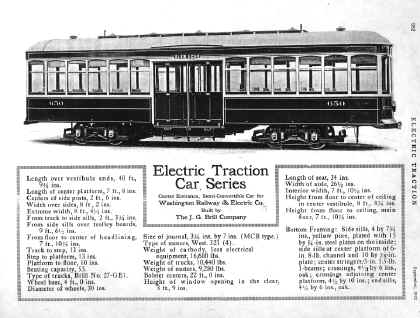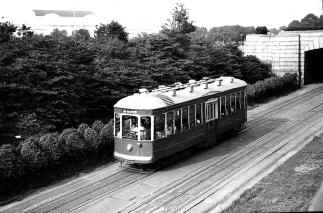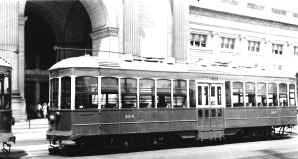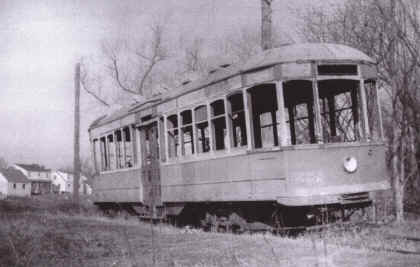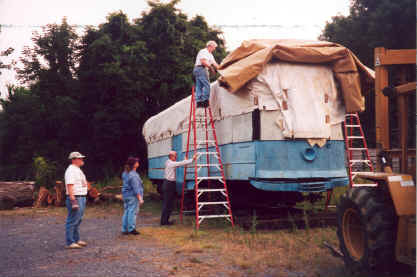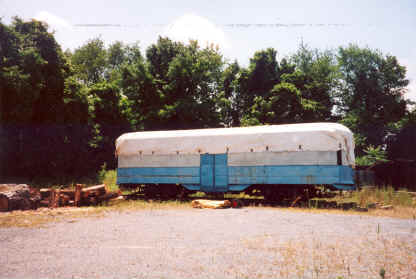|
|
Hoorah for WRECo. 650: The Long Road Home |
|
by Wesley Paulson |
Many of the surviving Washington, DC streetcars have interesting stories surrounding their existence since being removed from service. Cars are preserved in collections in Maryland, Pennsylvania, Connecticut, Maine, Sarajevo and Barcelona. While none of the stories to date can match the miraculous restoration of the ex-Washington PCC in Sarajevo, all are interesting tales for the distance that many of the cars has traveled on the way to being preserved in museums. However, none of the surviving cars has suffered under such good intentions as Washington Railway and Electric Company (WRECo.) No. 650.
J.G. Brill Company constructed WRECo. 650 in 1912 as the sample for a fleet of center door design cars that would eventually number 50. Designed by WRECo. Master Mechanic W. A. Wenner, the car combined the features of a semi-convertible body and a center-door design. In his book Capital Transit: Washington's Streetcars: The Final Era, Peter Kohler outlines in great detail the design, construction and operation of 650 by WRECo, and Capital Transit Company (CTCo.).
| Brill advertisement for No. 650, in the September 1912 edition of Electric Traction, shows the car in its original as built configuration. Image courtesy of LeRoy O. King, Jr. |
As the sample, WRECo. 650 featured a semi-convertible body, forced air ventilation and a unique pair of three-fold center doors that opened inward. The intention with the door design was to create a set of dividers to direct passengers boarding and leaving the car through the wide opening. The car rode on standard Brill 27E trucks.
By 1915, WRECo. had modified the design for the car body on subsequent car orders. Changes included replacing the wide three-fold doors with standard bi-fold doors, and changing the ventilation from forced air to a standard roof ventilator. Two narrow windows, on each side of the center doors, now fill the space where the doors were changed on WRECo. 650, in 1915, to standardize the car with the rest of the fleet. At this time WRECo. also raised part of the lower floor in the center step well in all of the center doors.
In 1933 WRECo. merged with Capital Traction Company, forming Capital Transit Company. Capital Transit renumbered WRECo. 650 to CTCo. 884.
|
|
| Capital Transit 884 leaving the west portal of the US Capitol tunnel ca. 1938. Jeffrey Winslow Photo, collection of LeRoy O. King, Jr. All rights reserved, this photo may not be used, or reproduced in any way, without written permission. |
Age, and the arrival of the PCCs in 1937, would bring the demise of the center door cars in Washington. With slower acceleration in city traffic the cars were no longer as efficient as they were in 1912. Mills Dean remembers the last years of the center door cars: "Once the new PCC's were delivered in numbers, these old Camel Back cars were found to be really slow. Going up Pennsylvania Avenue the PCC's and the ten hundreds would back up behind these old eight hundred series." Capital Transit removed the last group from service in September 1944. The center door cars had served Washington for 32 years. WRECo. 650 would soon begin its long trip from the Capital Transit's Falls Barn to the collection at the National Capital Trolley Museum.
|
|
| No. 884 at Union Station in the early 1940s. CTCo. shipped the car to New York in this condition in 1945. Note the narrow windows next to center door, installed when the doors were modified from three-fold to the production standard bi-fold in 1915. From the collection of LeRoy O. King, Jr. All rights reserved, this photo may not be used, or reproduced in any way, without written permission. |
Acclaimed by Brill Magazine as "one of the most interesting cars of the centre (sic) entrance type that has ever been built," WRECo. 650 presents excellent qualities for preservation. Roy King states "in a way, the center doors defined Washington because no one else had anything like them." The Washington design was only used elsewhere in Buffalo, NY, for one car, and Perth, Australia for two cars.
Beyond the significance of its initial impact on the operation of WRECo., the Washington center door cars were destined to attract the attention of railfans. Roy King writes: "the one thing I liked about the center doors is that you could sit right up by the motorman." And Richard Gross recalls: "I really loved the 'center-door' cars because it was fascinating to watch the center conductor collecting the fares." In later years, the cars were used most often on the Cabin John Line to Glen Echo Park, which further endeared them in the memories of Washingtonians.
In December 1944, the Capital Transit Company agreed to donate WRECo. 650, now CTCo. 884, to the Electric Railroader's Association (ERA) in New York City. There is no documentation for what prompted CTCo. to preserve the car. Ed Schell speculates that Edward Merrill, president of CTCo. may have been motivated by reading an article in the October 1944 issue of Transit Lines, the company's employee newsletter. At the time Schell was employed as a Traffic Clerk.
The Transit Line's article was about Ed Schell's interest in collecting transfers, and included a paragraph about Schell's membership in the Electric Railroaders Association, and his involvement in St. Louis Electric Railway Historical Society. The article stated that "this latter group has endeavored to preserve old streetcars, so that they won't entirely disappear from the American scene." To Schell's surprise, a letter later appeared on his desk in his office at CTCo. one day in December 1944. Recalling the event almost 60 years later, Schell said that in the letter Mr. Merrill offered then CTCo. No. 884 to the ERA.
Ed Schell was the Washington representative for the ERA. In a letter to Henry Leinbach dated February 1, 1945, Schell wrote "plans are well under way to move 884 to the Central Railroad of New Jersey
(CNJ) Bronx Term. where a place can be rented for $15 Yr." On April 16, 1945, Ed Schell reported to the ERA office in New York that
"No. 884 was taken today from Falls Barn to Benning and I rode the car. It has no apparent mechanical difficulty. The
No. 2 controller is possessed of several worn fingers. Car rides rather well at moderate speed, but at higher speed it bounces more than a PCC. As soon as flat is obtained from the PRR the car will be loaded for shipment to the CNJ Bronx Terminal."
In a letter to the ERA dated April 20, 1945, Schell describes the process of loading the car at
Benning: "It is my pleasure to report that the loading of car No. 884, ex Capital Transit Co. car, was completed at 3:50 p.m. on April 19, 1945 at the Benning Yard of the Capital Transit Co. The car was removed from the yard by line car
No. 099 and picked up as part of a train by loco No. 054 which transferred the car to
Potomac Electric Power Company (PEPCo.) interchange with the
PRR…. As to the loading of the car; 884 was run on the flat under its own power on Tuesday…" Schell's letter includes further comment that the car was loaded on the same car that brought
CTCo. No. 1502, a new PCC car, from St. Louis, and that much of the rigging for "884" was property of St. Louis
Car Co. Ed's letter concludes with "When you rec. 884 you will find the controls in sand box on one end
(No. 1 end I think). Note that the roof leaks at one place in the center by the doors. It should be repaired." It would soon be apparent that the leaky roof was the least of the concerns with the car.
Ed Schell's next letter to the ERA office in New York outlined the first damage done to the car. "During the day that 884 was out of the
CTCo. yard last week, it was entered and all light bulbs and 8 windows were smashed". Ed cleaned the car and located some replacement sash, which he packed on the car floor near the center door. The car suffered further on arrival in the Bronx. Schell writes to John Kneiling at the ERA on May 19, 1945: "I have Herman's
(Rinke) card re: damage done to 884. You sure picked one heck of a place to park that car. I could have found spots in Wash. to park where the brats wouldn't have broken it up any faster than it is being broken up there."
It was not long before the suggestion was made to involve the Branford Electric Railway Association
(BERA) with the care of the car. Robert S. Wilson of Yakima, Washington, addressed the issue in a postcard to Ed Schell dated October 31, 1945. " In regard to the Capital Transit 884, now in N.Y. and suffering damage from vandalism, I wish to suggest that you, if possible, investigate the possibility of having this transferred to the custody of the Branford Electric Railway Association in Connecticut…" An article in
CTCo. Transit Lines January 1946 with the headline "Railfans Preserve '884'" notes the possible move to New Haven and concludes with optimism: "So, before too long, '884' may once again react to 600 volts as a railfan motorman notches the controller up to 9 points."
Little is known about the status of the car until a letter dated May 12, 1947. In that letter the ERA transferred the title for the car to
BERA, Inc. along with $400.00 to assist with moving the car to the Connecticut Company's James Street car house in New Haven, where the growing collection of the BERA was stored. In a letter on August 22, 1947, Ed Schell records that "the car…is now at New Haven, and when fixed up by Conn. Co. will find its way to the new 30-car barn being built by Branford Elec.
Ry. Assn. on the Branford Line." The car, in turn, was towed in 1947 over the local Connecticut Co. lines to the newly acquired property of BERA in Branford Conn., where it languished outdoors for a number of years.
In late 1949, BERA appeared ready to scrap the car. A memo dated October 6, 1949 from Sid Silleck to Dick
Wonson:
I was indeed truly sorry to hear the results of Tuesday's meeting
[of the executive board]...before any physical action is taken
to scrap this car, Branford should consider all the angles.
When this matter first came up, I contacted the Washington division
of ERA (WERHS), who first obtained this car, to see if they could help.
They replied just this week that they have an agreement with CTCo.
to take over the Cabin John line when it is abandoned in the next
few years. They say, if we do not want the car, they certainly do, and
could store it in Kensington carhouse until they get the line.
| WRECo. No. 650 at Shore Line Trolley Museum, ca. 1954. Harry Hall photo, BERA Collections. All rights reserved, this photo may not be used, or reproduced in any way, without written permission. |
But weeks later, this possibility seems to have fallen through. On October 17, 1949, Robert S. Crockett representing the WERHS wrote to
BERA: Mr. Blaiklock, the equipment engineer of CTCo., stopped by
Branford last spring and looked over...884. He said that 884
was in very sad shape and that the wood had rotted. If the car had
been returned to Washington, CTCo. would have made any repairs
that are necessary, but they think that the car is in such shape that
it would cost quite an outlay of money to put it in any worthwhile
condition. Under those conditions and upon the advice of the Company
we think it best not to make any action in regard to 884.
Looking back to those early days, Henry Ruschmeyer continues the saga of WRECo.
650 in a statement dated April 14, 1978:
B.E.R.A. was also about this time faced with a financial dilemma in its formative years and decided to dispose of a number of its cars,-- including No. 884,---to any interested
person(s) or groups who could provide necessary cash. However, after the car was sold for scrap around 1952 to a local scrap dealer,---and without being removed from the property, --- I (and another now deceased member Harry Hall), bought the car back from the scrapper at about $1,000, and we subsequently managed to get the car housed and protected from further weathering."
Returning from a visit to Branford in 1958, Dick Kotulak reported in the Headway Recorder that the car was stored outdoors and was being used to store tools. In the early 1960s, BERA constructed car barn space and moved
WRECo. 650 to indoor storage. During the 1970s, BERA moved to secure museum ownership of privately owned equipment on its property. On December 28, 1977, the Museum acknowledged that Mr. Ruschmeyer had donated the car to the collection.
WRECo. 650 continued to enjoy the benefit of secure, indoor storage over the years. Branford wished to remain a "type collection", and so the car was protected by being the representative center door car for the museum.
During the 1980s, the leadership at National Capital Trolley Museum began work on a "General Plan for Defining Collections and Determining Facilities". This document recognized the desire to fill gaps in the Museum's collections while also outlining the need for improved facilities to meet the Museum's mission. The adopted plan called for the acquisition of
WRECo. 650 to join the Museum's Washington collection.
A group from NCTM traveled to BERA to inspect WRECo. 650. The visitors confirmed that the car body was sound, but stripped of all fixtures and accessories. More importantly the car retained all running gear (trucks, motors, grids, compressor). Based on these findings, and following the recommendations of the General Plan, the Museum wrote to BERA in 1990 to begin negotiations to return the car to the Washington, DC area.
Writing on behalf of BERA on June 9, 1990, curator Michael Schrieber offers: "If NCTM can acquire a suitable replacement center-entrance car and deliver same to BERA's railroad in East Haven Connecticut, BERA would be willing to donate No. 650 to NCTM so that the few remaining Washington streetcars can be preserved at a single location." Concurrent with this offer, the Museum learned that SEPTA, the transit authority in Philadelphia, PA, was disposing of its remaining Red Arrow center door car later in that same year. An effort was mounted to seek cooperation from the trolley museums in Pennsylvania and allow NCTM to acquire Red Arrow 73 for a trade to BERA.
However, the Pennsylvania Trolley Museum wished to add Red Arrow 73 to its collections and the plan failed. A Red Arrow center door body was then located in Indiana. This car, Red Arrow 68, was previously stripped of original running gear and was not found by BERA to be suitable for trade as outlined in their offer.
After this flurry of activity, the negotiations stopped. WRECo. 650 remained in Connecticut. During the winter of 1992-1993 there were two severe coastal storms that flooded the BERA site. As if the early years of vandalism were not enough to test the durability of the car, WRECo. 650's motors were twice flooded with salt water that winter.
| Photo of NCTM volunteers covering WRECo. 650 with a full tarp in June 2002. Wesley Paulson photo. |
An unusual discovery in Scranton, PA began process that would finally see WRECo. 650 return home. Workers demolishing a restaurant near Scranton, PA in 1999 uncovered the body of Scranton Railway Co. 324, a 1903 Brill Semi-convertible. The fledging Electric City Trolley Museum (ECTM) saw the potential to restore this car for their new operations in Scranton adjacent to Steamtown. Working with Bill Wall at BERA, ECTM was able to negotiate a trade that would release Red Arrow 75, a center door car, to BERA, while NCTM would assist in purchasing parts for the restoration of the Scranton car body, and in return receive WRECo. 650. NCTM and BERA signed an agreement on May 8, 2001 to transfer WRECo. 650 to NCTM.
| June 2002 side view of WRECo. 650 on storage track at National Capital Trolley Museum. The blue paint was applied by Shore Line Trolley Museum in 1995 when the car was moved to outdoor storage. Photo by Wesley Paulson. |
Silk Road Transportation Co. delivered WRECo. 650 to NCTM's site in Maryland on June 28, 2002, 90 years after the car was first received in Washington. After being badly damaged in the Bronx, saved by BERA in 1947, saved again by Ruschmeyer and Hill in 1952, reclaimed by BERA in 1977, and then flooded by storms in the 1990s, Washington's first center door, and now its last, has returned home. In a recent email to the author Russ Jackson, a member of BERA, sums up the saga of WRECo. 650: "When you think about it, it is amazing that it exists. Had it been found on some farm complete with underfloor equipment, imagine the hoorah."
